On a Fresh Rebuild 2-stroke Head Gasket Blow Do You Have to Do the Heat Cycle Over Again

The majority of today'due south engines consist of a four-stroke design that utilizes three fluids: combustible air fuel, water/glycol coolant and motor oil. None of these fluids can always come into contact with each other. To ensure these fluids are properly routed between components with no intermixing, there's the head gasket.
In this commodity:
-
- What is a Head Gasket?
- What are the Signs & Symptoms of a Blown Head Gasket?
- The Trouble with Ignoring Blown Head Gasket Symptoms
- How to Minimize Head Gasket Bug
- How to Tell if You lot Take a Blown Head Gasket
- Visual Signs of Blown Head Gasket Symptoms
- Tin You Bulldoze with a Blown Head Gasket?
- Is the Car All the same Safe for Driving?
- How Much Does it Cost to Set up a Blown Head Gasket?
- Bar's Leaks Solutions for a Diddled Head Gasket
What Is a Head Gasket?

In automobile engines, the head gasket is a ringed panel that is placed between the cylinder head and engine block. The head gasket is put in place as a barrier that prevents engine fluids from leaking into the cylinders. As such, the caput gasket is among the most vital components in the combustion sleeping room. In addition to serving as a barrier to the cylinder, the head gasket blocks off conduits to the oil and h2o. Due to its position betwixt hot and cold engine components, the head gasket faces a full range of temperatures, from the high heat of the combustion chamber to the often cold temperatures of the cooling organisation. As the impacts of temperature changes take their cost over time, the head gasket can ultimately conduct marks forth the surface. Consequently, leaks do ofttimes develop along this crucial area. If the problem worsens, the gasket can blow — all of which begs the question: What is a blown head gasket?
What Are the Signs and Symptoms of a Blown Head Gasket?

A driver volition ofttimes wonder what causes a blown head gasket. The truth is, anything from the coolant arrangement to the combustion chamber could be responsible. Most confusing is the fact that symptoms which resemble those of head gasket failure will sometimes originate from other causes. In certain cases, a symptom might show due to multiple failures inside the engine. Examples could include the following:
- Overheating could be caused past a restricted radiator, which can get worse the further y'all bulldoze forth.
- Coolant in the oil, usually blamed on caput gaskets, could actually be due to issues with the intake gasket.
Symptoms such as these may or may not be due to the head gasket. An accurate diagnosis frequently depends on the expertise of a skilled technician.
The Trouble with Ignoring Blown Caput Gasket Symptoms
Often times, a commuter will ignore blown head gasket symptoms due to the costs that come with repairs. This can be an even more plush fault, however, because in many cases, blown head gaskets atomic number 82 to further automobile trouble if you lot continue driving. A coolant leak, for instance, could lead to the following problems:
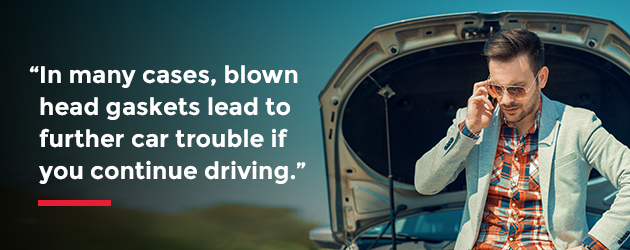
- Damage to the catalytic converter
- Leaks into the engine oil, which tin can ruin the engine
- Erosion of lubrication
- Overheating caused past mixtures of coolant and combustion gases
Furthermore, mixtures of coolant and hydrocarbons can crusade corrosion, which tin can damage various engine parts similar the radiator and heater.
Other Blown Head Gasket Signs? Possibly, Mayhap Non
So why is it often hard to go an accurate diagnosis of a blown head gasket? A lot of the problem is due to the similarity betwixt issues with head gaskets and other engine components, such equally the following:
- A chipped or warped cylinder head, which could affect the caput gasket, but wouldn't necessarily exist the consequence of a blown head gasket
- Corrosion at the surface of the head gasket, which would bespeak a leak, merely 1 that wouldn't necessarily exist due to a caput gasket blown
In such examples, the only manner to really know whether the bug extend directly from the caput gasket is to remove the head and put it to a test.
Related Symptoms of Diddled Head Gasket Trouble
When head gasket failure occurs between two or more cylinders, several symptoms are bound to result. The well-nigh common symptom in this case is a misfire, which would result from the leakage of compression between cylinders. Prove of this could include the following:
- Lowered compression due to rough idling
- Overheating of the engine
- Coolant leakage to the oil compartment
- Coolant on top of a spark plug
The failure of a head gasket between a coolant port and cylinder can cause leakage of the former into the latter. When this occurs, a misfire is likely to happen during vehicle ignition, especially if the motor is revved up, cutting and so restarted. While such a problem might evade a regular compression examination, it could exist more easily identified by revving the engine immediately later putting the cooling organisation to a pressure test.
Overheating Due to a Blown Head Gasket
When the failure of a caput gasket occurs between the cooling system and combustion bedchamber, the prove is typically displayed by coolant loss and overheating problems. The latter symptom tin can exist peculiarly troubling because overheating often only shows in fits and starts, such as when a vehicle has been on the road for some distance. Withal, overheating can besides do harm when it doesn't become apparent, such equally during short trips along wearisome roads. For example, if you lot drive from your house to the nearby grocery store, your car might non exceed 35 mph for the trip. Therefore, the auto won't accomplish the superhighway speeds that would more than likely arouse an overheating issue. Nonetheless, the problem will nevertheless simmer inside the engine, fifty-fifty if y'all don't stop upwards seeing the rut gauge spike or any smoke seep from the hood of the car. In cars where overheating does not become readily apparent, damages caused by combustion gasses could include the post-obit:
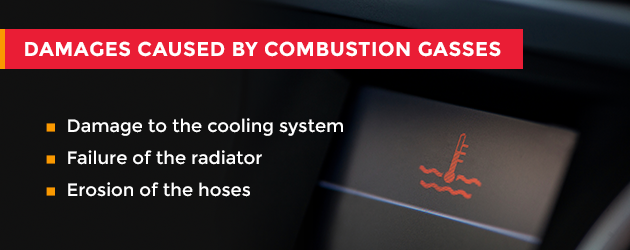
- Damage to the cooling arrangement
- Failure of the radiator
- Erosion of the hoses
In some cases, one such trouble might ship off a chain reaction, such as where cooling system failure spreads to the radiator. The trouble is, both could exist damaged by overheating regardless. When a automobile gets misdiagnosed or when the driver skimps on repairs, there might be 1 component that is already ruined and several others that are significantly damaged, but the driver might only want to replace the component that's shot. Consequently, the other weakened parts might soon fail as well, and this could negatively impact the newly replaced component. Often times, problems such as these are triggered non from overheating, but by other causes. One example would be a leak in the water pump, which could impairment the cooling system and in turn make the engine overheat. Every bit an example of the domino effect with these kinds of issues, the water pump could be replaced, only for the other bug to continue, worsen and ultimately ruin the new pump. Then again, a water pump replacement might set the problem, but only temporarily. Sooner or later, the head gasket could plummet — its weakness having been initiated during the overheat. Simply put, overheating can frequently be the gift that keeps on giving.
Blown Head Gaskets and Nearby Components
Another source of trouble is when a head gasket fails between the coolant and lubrication components. A telltale sign of this is when the fluid from one seeps into the other. Typically, the first symptom to show in such cases is when the radiator cap swells. Notwithstanding, the problem tin can be harder to spot in cars that use glycol oil, which is less likely to take on a milky advent when corrupted. When a trouble like this occurs, the viscosity of the oil is affected, and this volition ultimately compromise the engine's lubrication. While information technology's mutual for head gasket failure to be misdiagnosed as something else, at that place are as well times when a trouble thought to be related to the caput gasket and components nearby is actually its ain matter entirely. An oil leak, for instance, is something that often happens independently of the caput gasket, which in itself is rarely a cause for such leaks. Worn valve covers, on the other hand, are oftentimes responsible for oil leaks — though not in all cases. As such, the post-obit misperceptions often persist:
- The head gasket couldn't perhaps be responsible for an oil leak.
- If there'due south an oil leak, information technology must be due to a faulty valve cover.
In cases where oil drips from under the transmission, it's sometimes mistaken for a leak in the pan gasket or rear seal. Granted, a head gasket can go amiss in numerous ways, and various types of failure — including oil leaks — can occur simultaneously equally a result. Withal, an external oil leak is its ain trouble that may or may not be related to the head gasket.

How to Test for a Diddled Head Gasket
A reliable style to determine whether a head gasket is diddled is to test for carbon dioxide. In this examination, the coolant is examined for traces of combustion gasses. The test is performed with an apparatus that utilizes a solution that changes color upon contact with carbon monoxide. The steps are as follows:
- Lower the level of coolant in the radiator (to provide a testing air space).
- Warm the engine (for improved accurateness).
- Use the tool to extract fume samples from the coolant.
- Mix samples in testing solution.

If the solution turns yellow, the coolant has failed the exam, which indicates a problem. Granted, the test doesn't always work, and carbon dioxide could notwithstanding be present in the coolant without a change in colour to the solution. Nonetheless, the test is generally reliable at detecting a problem that is symptomatic of an unhealthy engine. Another problem that a carbon dioxide exam could maybe reveal is a ruptured cylinder head, which causes similar symptoms to a failed head gasket. In many cases, a cylinder head cleft volition be as well tiny for the man centre to spot, yet it could still be a major problem. At some repair shops, cracks are found with the use of dyes or the application of force per unit area tests. Every bit with coolant tests, cylinder head testing is best washed by a professional person auto technician.
Automobile Designs and Faulty Head Gaskets
In overhead cam engines, the gasket tin only be accessed past taking out the front and peak of the engine, which ordinarily entails removal of the timing chain or chugalug. In some makes and models, most of the engine must be removed in order to proceeds access to the caput gasket. The failure of a head gasket is sometimes due to limitations in the vehicle'due south engine pattern. Consequently, maintenance of the cooling system with quality fluid and top-ups is evermore essential in today's cars. In modern engines, normal temperature levels identify in the range of 200 to 225 °F. Therefore, when a temperature gauge rises to the hot zone, it ways that the engine is really hot. If an engine rises above 240 °F, the head gasket and cooling system could both be pushed across their normal limits. If the engine soars past 260 °F, the impact is almost inevitable.
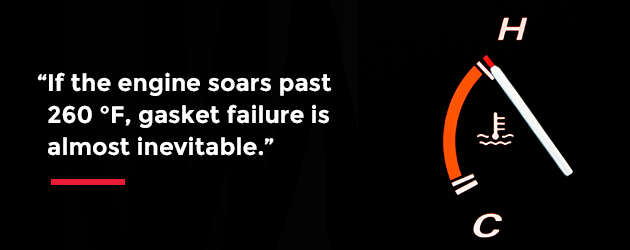
Another factor that can pb to gasket failure is low-grade fuel, which is often responsible for backlog pressure level on the cylinder head. This is due to detonation and pinging, which often occur when fuels with lower-than-recommended octane levels are used in an engine.
How to Minimize Head Gasket Problems
In club to minimize the chances of head gasket failure in your vehicle, perform the post-obit steps accordingly:
- Before the coolant drops below a pH of 7.0, refill the reservoir.
- Utilize readymade coolant/water mixtures — never add the ii separately.
- Cut the engine the moment it overheats.
- Examine and remedy the conditions of overheating. Accept the engine professionally diagnosed if necessary.
There are certain automakers that take been notorious for producing automobiles in which the head gasket can hands blow. In some cases, problems related to caput gaskets take prompted vehicle owners to petition the automakers in question, demanding that the vehicles be recalled. Regardless, caput gasket bug can still be remedied and overcome without spending a fortune on replacements and repairs.
How to Tell If Y'all Have a Blown Head Gasket
Due to its obscured placement between components in the engine, the head gasket cannot exist examined without major disassembling work. That ways it'southward difficult to brand a diagnosis on a gasket'due south condition, but visual inspections are rarely useful at pinpointing head gasket problems anyhow. The best style to diagnose a problem is to study the symptoms as they occur and accept a noesis of what they nigh probable hateful. Common symptoms of a blown head gasket include the following:
- External leaks of coolant from nether the exhaust gasket
- Overheating under the hood
- Fume blowing from the exhaust with a white-ish tint
- Depleted coolant levels with no trace of leakage
- Chimera formations in the radiator and overflow compartment
- Milky discoloration of the oil

From a purely visual perspective, the most surefire prove of a diddled head gasket is the presence of leaked coolant along the gasket surface. In the majority of cases, leaks occur between the engine's combustion and cooling components.
Visual Signs of Blown Head Gasket Symptoms
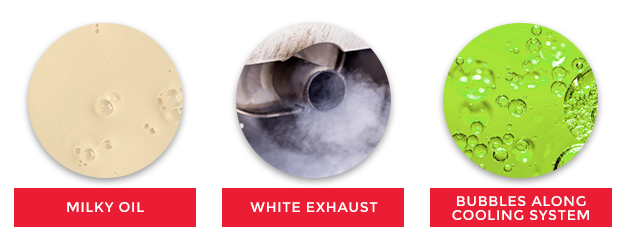
When the combustion sleeping room gets penetrated with coolant, the engine loses its equilibrium and its ability to go along heat levels from rising as the car moves faster forth roads and freeways. Every bit a result, the engine is likely to overheat unless the coolant is refilled on a abiding basis. The problems don't stop once y'all park the auto, either. Later on the engine is shut off, coolant that lingers in the cylinder can leak into the engine oil. This newly corrupted oil will ofttimes assume a milky appearance that can normally be identified with an inspection of either the dipstick or cap rings. When the engine runs, white fume will course from any is left of the coolant inside the combustion chamber. The smoke in question is easiest to identify on warm days, when it can often exist seen blowing from the exhaust pipes equally the car sits warm and idling. On cold and moisture days, the fume is harder to identify due to the increased likelihood of steam, which has a like advent. Alternately, symptoms such as these tin be identified by certain smells. A sweet scent, for instance, is normally indicative of a caput gasket trouble. In the midst of all these problems, exhaust gases from the combustion chamber could enter the cooling system, where they'll circulate and pass to the radiator. The easiest place to spot evidence of this is in the cooling tank, which may contain bubbling as a result of pressurization. The cooling system remains pressurized for as long every bit the engine is warm, and so the radiator cap should never exist removed while the engine is idling or has just recently been shut off. In curt, some of the most telltale visual signs of a blown head gasket include:
- Milky Oil
- White exhaust
- Bubble formations along the cooling system
If your vehicle exhibits i of these symptoms, there'south a good adventure — though it's not entirely sure — that your engine has diddled its head gasket. If ii or three symptoms are axiomatic, then in all likelihood yous probably do take a blown gasket. In the upshot that your gasket is most probable blown, refrain from driving your car much, if at all, until the problem is rectified. The components that connect to the gasket tin can become warped or irreparably damaged from the temperature extremes and fluid leaks that head gasket issues can cause, all of which could consequence in huge repair bills. In a worst case scenario, the engine might need to be replaced outright.
How to Spot Signs of Blown Head Gasket Trouble in Newer Vehicles
In today's automobiles, the cylinder head contains diverse coolant passages, which allow heat from the engine to escape with each passing mile. The purpose of the head gasket is to prevent coolant from flowing through these passages into the combustion chamber. However, when the gasket ruptures, all goes awry:
- The engine gets flooded with coolant.
- The coolant gets consumed with frazzle gasses.
- The engine rapidly overheats.
The easiest manner to audit a machine for a blown head gasket is to look for the following signs of testify:
- An overabundance of steam coming out of the exhaust pipage
- Bubble formations in the coolant reservoir
If the steam feels damp to touch or if the bubbles appear to have seeped from the engine'due south inlet, chances are at that place's a head gasket trouble.
Oil Characteristics With a Blown Caput Gasket
The purpose of oil passages — which exist in equal proportion betwixt the cooling system and cylinder head — is to allow for the transfer of oil from the cylinder into the train valve and back. When the head gasket blows, the engine consumes oil at excessive rates. Granted, cases of excess oil consumption can likewise be due to other causes, such as weakened piston rings. All the same, in a big number of vehicles, called-for through oil much faster that an engine is supposed to within a given bridge of time is normally the consequence of a blown head gasket. Common symptoms of backlog oil consumption include the following:
- Excessive exhaust with a faint blue or whitish tint
- Macerated idling ability
When symptoms like these occur, a machine should be inspected for issues with the caput gasket. Of all the symptoms that stem from a blown caput gasket, few are as dangerous equally the mixing of fluids that are non supposed to come into contact — namely coolant and oil. When the coolant seeps into the oil, the oil'south backdrop can become corrupted to the point where the engine is robbed of its lubrication. When you consider how oil is the lifeblood of an engine, the leaking and mixing of fluids acquired by head gasket failure is basically a car's equivalent of a lethal injection. In short, the consequences of corrupted engine oil are as follows:
- Loss of proper viscosity
- Diminished ability to lubricate the engine and all of its moving parts
- Erosion of fundamental engine parts and bearings
If an inspection of the dipstick shows the oil to exist bubbly, watery or chocolate milk-like in appearance, the engine is indeed showing symptoms of a blown head gasket, the likes of which could be due for emergency maintenance
Tin Y'all Drive with a Blown Head Gasket?

Given the high costs associated with head gasket replacement, 1 of the about frequent questions that car mechanics hear from drivers is "how long can you drive with a blown head gasket without doing serious damage to the engine?" It really all boils downward to the severity of the problem. If you only come across a slight loss of pressure level under a hard load, y'all only take a slight problem with the head gasket. Even so, if yous observe yourself repeatedly adding coolant to the engine only to keep information technology from overheating, yous've got a serious problem on your hand that will inappreciably be staved off with the stopgap method of coolant top-offs. Even if the engine doesn't overheat, information technology could still incur irreparable damage over a brusque catamenia of time if constantly placed under high-pressure conditions. People also wonder if information technology'south safe to drive a vehicle when the engine pushes coolant merely slightly, simply without evidence of gushing or clouds of white exhaust. The answer hither is yep and no. In order to really know, you need to test the vehicle first.
How to Examination a Caput Gasket to Come across If the Car Is Still Safe for Driving
For the following examination and for as long as the engine has gasket issues, keep a few gallons of 50/50 coolant on hand. Cheap coolant will suffice in this experiment since it'southward going to be flushed out of the engine anyhow:
- Make full the coolant upward and drive the car around with the coolant cap loose.
- Let the speed work its way up to about 50 mph.
- Bulldoze around for an afternoon and see how much coolant the engine consumes during a 50-mile trip.
If you just need to add a half-gallon of coolant every 100-150 miles, your motorcar is safe to drive for reasonable distances during the cooler days and months of the year. Nevertheless, hot outdoor temperatures will bear on the engine's heat and tin make a car with even small gasket issues less safe for trips of considerable distances. Each time yous add liquid to the coolant system of a heating engine, the liquid must exist at least a l/50 mix of coolant to water. Never pour common cold water into a hot motor — cast atomic number 26 will not withstand this. Common cold water in a hot motor could also stop upwards cracking the head, which could toll yous a whole lot more money in repairs. Driving with a blown head gasket over distances of 1,000 miles or more than is another thing. Doing and so tin actually wear away textile effectually the coolant jackets. Basically, driving around on a diddled head gasket is something that can be washed for moderate distances at moderate speeds with coolant on hand. The thing to sympathize is that yous can't await to keep this method up indefinitely. Coolant superlative-offs are a stopgap measure out you can use with a vehicle with moderate gasket problems until you set bated the funds for engine repairs.
How Much Does It Cost to Fix a Blown Head Gasket?

Due to the deep placement of head gaskets in modern engines, the replacement costs for gaskets and cylinder heads are by and large expensive. However, for cars that show but mild to moderate symptoms, depression-cost alternatives do be. Principal amid these options is our honour-winning, mechanic-tested range end leak products, which can relieve you lot of your blown head gasket repair price concerns. Bar's Leaks has long provided professionally-proven chemical solutions to a range of auto problems, from head gasket issues to coolant and oil leaks. When information technology comes to problems with the head gasket, repairs are often outside the upkeep range of the average commuter. On older cars in particular, the investment required for a mechanical blown caput gasket fix is often not worth it, considering the value of the car. For just a fraction of what you'd spend for an outright gasket replacement, our products will get your machine back out on the road and driving again.
Bar's Leaks Solutions for a Blown Head Gasket
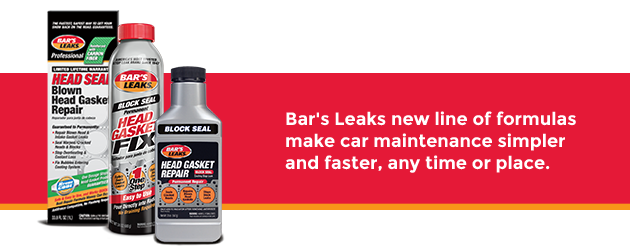
By far the almost common question we become on our tech lines and Facebook is: "How can I tell if your caput gasket products volition set my caput gasket leak? I've heard some of these products don't piece of work." There is one bottom-line truth, no matter what any chemic tool company tells you: if your head gasket leak is also severe, no chemic repair volition seal the leak. We'd love to tell you lot otherwise, but we're e'er honest with our customers. If your leak too advanced, and so y'all're looking at a physical repair. But there are many steps between a healthy head gasket and a blown caput gasket, and that'due south where we come in. So, here's how to tell if your blown head gasket is a proficient fit for one of our caput gasket repair solutions:
Can your automobile run or exist driven for 15 minutes without overheating?
First, the bad news: if your vehicle cannot run for 15 minutes without overheating, your leak is probably too severe to be chemically sealed. In cases similar this, there is less than a 50% gamble we can aid. If your vehicle can run for 15 minutes without overheating, so our strongest product, Bar's Leaks Professional Head Seal Diddled Head Gasket Repair (p/n HG-1) will probably work. HG-ane is our nigh expensive product, ane that's truly commercial-grade, but it'due south as well our strongest formula, designed for the toughest leaks. It'south too very easy to install, with no draining or flushing necessary unless the cooling system is muddied or partially clogged. But wait. Earlier you determine on our HG-1 product, in that location is another question:
Tin your car run or be driven for xx minutes without overheating?
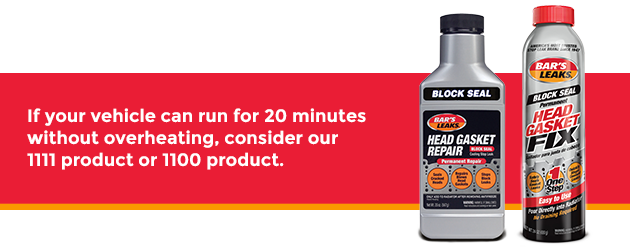
If so, and then yous are probable a good fit for our Bar's Leaks Caput Gasket Fix (p/n 1111), 1 of our virtually wildly pop products. Why is it pop? It has a medium price betoken and is very easy to install because it'southward antifreeze-compatible. Its sealing ability is a fleck below our HG-i product, but the installation is quick and easy. For nigh moderate HG leaks, this product has worked for hundreds of thousands of customers. If y'all desire a cheaper, but too strong product whose installation is a scrap more involved, our Bar's Leaks Head Gasket Repair (p/n 1100) is a nifty choice. Information technology offers a very stiff seal and a lower price, but installation is more demanding because the formula is not compatible with antifreeze. So, basically speaking, this is how you can tell if one of our products can help with your blown head gasket:
- If your vehicle tin can run for 15 minutes without overheating and y'all demand our nearly professional person-form solution, consider our HG-ane production.
- If your vehicle can run for 20 minutes without overheating, consider our 1111 production or 1100 product, depending on how like shooting fish in a barrel y'all want the installation to be.
- The real, honest truth that most chemical repair companies won't tell you: If your vehicle overheats within xv minutes, chances are you lot need a hard-function repair by a qualified mechanic. We'd beloved to be able to sell you a production, but if your car is overheating quickly, no chemical ready will work. It's not just ours that probably won't work, but any. Save your money for a mechanic's attending.
Set Your Motorcar the Piece of cake Way with Bar's Leaks Products
For just a tiny fraction of what you would pay to have your engine components removed and replaced, Bar'due south Leaks products will put a stop to mild and moderate leaks in a vast majority of situations. Our products require no special expertise to apply — our formulas can instantly transform whatsoever vehicle owner into their own mechanic. Whether you have to pull into a driveway or off to a roadside due to a trouble with the caput gasket, cooling system or oil, a unproblematic make full of our stop leak formulas tin have you back on the road in minutes flat. Operating but outside the Motor Metropolis — Detroit, Michigan — Bar's Leaks formulas have stopped leaks and solved problems for vehicles from effectually the country since the 1940s. As proof of the legendary power behind Bar's Leaks solutions, our products were used during the world'due south kickoff nuclear trans-polar submersible mission by the USS Nautilus in 1958. If our stuff works in mission-critical armed forces applications, it will piece of work for y'all. In our vii decades at the forefront of terminate-leak innovation, our products accept saved untold sums of money for millions of drivers by enabling simple repairs of what would otherwise be costly workshop concerns. If your motorcar or truck has a mild or moderate effect with the head gasket, cooling organization or whatsoever other fluids, don't blow a fortune on a new engine when Bar's Leaks formulas tin can solve the problem. To larn more nigh our products or to locate a store nearest yous, click on over to our products and locator pages.
Source: https://barsleaks.com/gaskets/symptoms-blown-head-gasket/

Post a Comment for "On a Fresh Rebuild 2-stroke Head Gasket Blow Do You Have to Do the Heat Cycle Over Again"